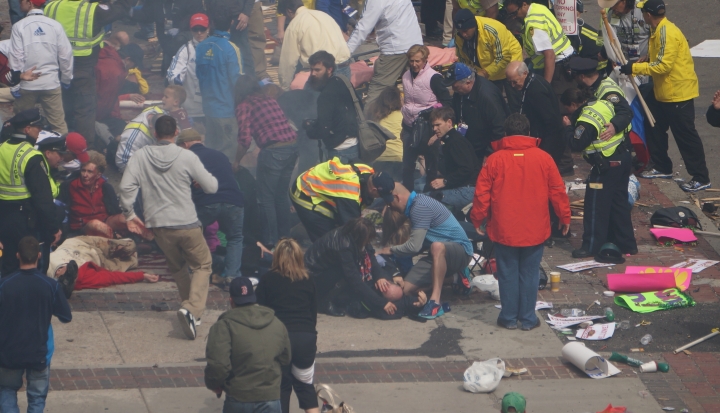The Boston Pilot carries Christopher Pineo’s poignant story about two priests held back from the site of the Boston Marathon bombing by police after rushing there to accompany the injured and dying (earlier reported in the Wall Street Journal).
Oblate Fathers Tom Carzon and John Wykes separately left St. Clement Eucharistic Shrine, not far from the bombing site, when they heard the sirens. Both said they were stopped by police about a half mile from the site. Wykes, who had brought sacramental oils with him, told the Pilot:
“I went up closer to the two police officers. I said, ‘I’m a priest.’ I showed them my collar and they said, ‘Get back.’ I said, ‘I have oil of the sick and I would like to see if I can help.’ One of them said, ‘What do you think Father? What do you think?’ Then he said, ‘Get back.’ So, I turned around and walked away,” he said.
He also acknowledged that the response from police in that situation was understandable.
“I think they were just trying to get everyone away,” he said.
The earlier Wall Street Journal piece by Jennifer Graham raised the question of whether the two priests, and others who had also approached, should have been admitted to the scene as emergency personnel. Wykes said that as a hospital chaplain in Illinois ten years ago, he was routinely granted access to accident and crime scenes.
Two of those who died in the Boston bombing, 29-year-old Krystle Campbell and 8-year-old Martin Richard, were Catholic. “As Martin lay dying,” writes Campbell, “priests were only yards away, beyond the police tape, unable to reach him to administer last rites—a sacrament that, to Catholics, bears enormous significance.”
In the Pilot story, Carzon and Wykes appeared to go out of their way not to blame police, while at the same time asking whether priests could in future be considered first responders:
“The twist that this story has taken in some places just doesn’t reflect my experience on that day at all,” said Carzon.
Father Carzon said he understood the police turning people back, including clergy, in light of the situation.
“They were trying to keep safe a very unstable, chaotic area. Even the police who were there on the perimeter, they had no idea what was behind them. All they knew was that they needed to clear out the area, and they had no idea how much they themselves were standing in harm’s way,” Father Carzon said…
Father Wykes said he thinks the decision by officers in the moment to turn the priests away came as a mixture of a cultural shift in the view of priests as first responders and a reaction to a chaotic situation that he called “pandemonium even if there is no bomb on Patriot’s Day.”
“They were confronted with an extremely difficult situation, trying to secure an area where there were just thousands and thousands of people, and trying desperately and very quickly to get those people out of the area before any more bombs blew up,” he said. “So, I understand the great difficulty that they went through in trying to protect people. But, that said, I think that there was a time when if you had a collar you were just let in to any kind of emergency or difficult situation,” he said.
He said he would like to see a level of cooperation between priests and police, whereby in the future priests could register or have an ID to present to police in similar circumstances.
“I certainly admire their work, but I look forward to working with them as an emergency responder if at all possible,” Father Wykes said….
A media affairs officer with the Boston Police Department told the Pilot that the priority of officers on the scene was to protect bystanders including the priests, to avoid contamination of a crime scene, and to follow an order given at the time to allow no more people into the area because of the potential of additional explosions.
Wikimedia photo cc by Aaron "tango" Tang








